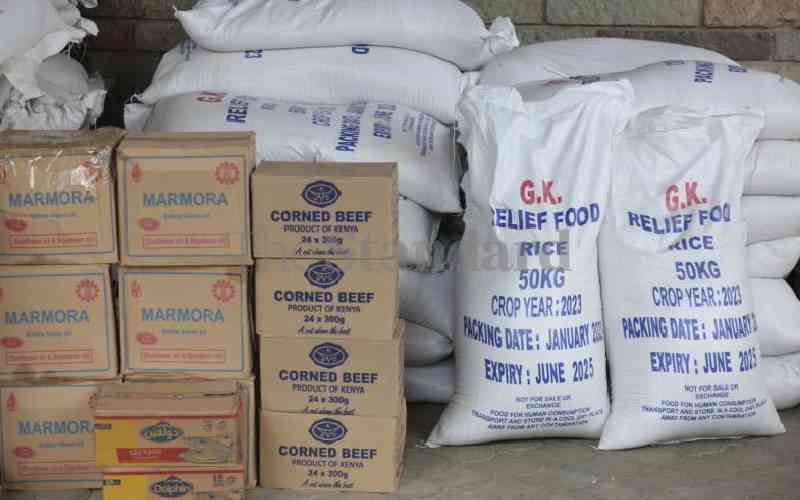If bands of locusts have reached Mandera, Wajir, Marsabit, Garissa, Isiolo, Samburu, Meru and Laikipia counties, it is because the ministry concerned and the national government have been inept in handling the menace. We have been told that the government has established "multi-sectoral systems, tools and mechanisms for a timely response". How could they wait until the locusts travelled hundreds of kilometres to reach central Kenya? The marauders are eating their way forward to greener destinations. They consume their own weight and a little more every day.
The weather has been good for them as the ground is wet and encouraging rejuvenation. That means that the swarm and band populations are increasing exponentially, making it more difficult to spray them effectively.
I hear people say one way of fighting the locusts is through noise. The struck areas are in the thousands of square kilometres. With what would one make noise to deter or kill them? People are talking of spraying insecticide. Which insecticide? Where does one get it and at what price? We are not being told. Furthermore, desert locusts usually fly at a speed of about 16-19 km/h depending on the wind. Swarms can travel about 5-130 km or more in a day. Locusts can stay in the air for long periods. That makes the farmer just a spectator.
Has the government established the species of locusts that have invaded Kenya? We have three species which could reach Kenya. There is the African Migratory Locust, the Tree Locust and the Red Locust, commonly known as the Desert Locust due to its ability to migrate over large distances while rapidly increasing its numbers. At its peak, a swarm of red locusts could comprise as many as 30-40 million strong in a square kilometre. That is an invading force that could rival several battalions of real soldiers.
Havoc they unleash
A swarm comprising 40 million locusts can eat an amount of food for about 35,000 people, 20 camels or 6 elephants. A swarm the size of Paris eats the same amount of food in one day as half the population of France; the size of New York City eats in one day the same as everyone in New York, Pennsylvania and New Jersey. The swarms in Kenya now may be bigger. The minister should tell us how big they are.
The swarms that entered Kenya from Abyssinia (Ethiopia) in late 1955 into early 1956, cost the Desert Locust Control Organisation over $2.4 million and involved 5,000 tonnes of bait with 300 vehicles available throughout the control area. The invasion that descended on the western half of the Northern Frontier District consumed 400 tonnes of bait and lasted 4 months, killing 28,000 hopper bands. How are the Desert Locust Control Organisation - EA and the FAO involved in the current campaign and how much have they spent? Kenyans need to know.
The swarms sighted in Kenya are not as dense as what might be witnessed in a few weeks time. The Sh30 million released to fight the locusts is laughable. Someone has not appreciated the havoc they can unleash. Tell the people how many vehicles are dedicated to the fight, how many tonnes of bait is available and where supplied or stored, how many experts are dedicated to this, how many people are engaged by the government or counties in the fight. Tell the people how many spray-aircraft are actively spraying. How many swarms and hopper bands are there and where are they heading and at what speed? Please note that if they reach the agriculturally rich parts of those counties already affected, Kenya will need to import huge amounts of emergency food. Locusts devour, they don’t joke.
Another issue concerns propagation. Did these swarms slow down long enough in places where they could lay eggs? If they did, the eggs would hatch in about two weeks, the hoppers would develop in five to six stages over a period of about 30-40 days, and adults would mature in about two to four months. Then they would form swarms of their own. It is important to know where the eggs were laid and to decimate the young before they do damage. Unfortunately, ordinary satellites cannot detect individual locusts or swarms.
Difficult to access
Asking chiefs and headmen to act as scouts to detect presence of locusts is the height of incompetence. We should have trained men and women scouts who know what to look for and who can monitor situations in Mandera, Wajir and Moyale. Those are the entry points.
Finally, why are these desert locusts so difficult to successfully combat? Firstly, they can be found in an extremely large area. Secondly, those areas are difficult to access. Thirdly, in some areas the insecurity is foreboding, land mines, et al. Fourthly, there are limited resources for monitoring and control. Lastly, it is difficult to predict outbreaks due to their errant nature and uncertainty of rainfall in locust areas. The consolation is that locusts do not attack people or animals or carry diseases.
-The writer is a lawyer
 The Standard Group Plc is a
multi-media organization with investments in media platforms spanning newspaper
print operations, television, radio broadcasting, digital and online services. The
Standard Group is recognized as a leading multi-media house in Kenya with a key
influence in matters of national and international interest.
The Standard Group Plc is a
multi-media organization with investments in media platforms spanning newspaper
print operations, television, radio broadcasting, digital and online services. The
Standard Group is recognized as a leading multi-media house in Kenya with a key
influence in matters of national and international interest.
 The Standard Group Plc is a
multi-media organization with investments in media platforms spanning newspaper
print operations, television, radio broadcasting, digital and online services. The
Standard Group is recognized as a leading multi-media house in Kenya with a key
influence in matters of national and international interest.
The Standard Group Plc is a
multi-media organization with investments in media platforms spanning newspaper
print operations, television, radio broadcasting, digital and online services. The
Standard Group is recognized as a leading multi-media house in Kenya with a key
influence in matters of national and international interest.








